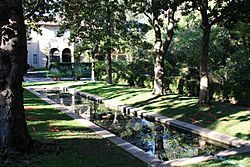Blake Garden (Kensington, California) facts for kids
Quick facts for kids Blake Garden |
|
|---|---|

Blake Garden
|
|
| Lua error in Module:Location_map at line 420: attempt to index field 'wikibase' (a nil value). | |
| Type | Public |
| Location | Kensington, California, United States |
| Nearest city | Kensington, California |
| Area | 10.6 acres (4.3 ha) |
| Created | 1957 by |
| Status | Open year round |
| Website | Official Blake Garden website: http://blakegarden.ced.berkeley.edu/ |
Blake Garden is a 10.6 acre (4.3 ha) landscape laboratory and public garden located at 70 Rincon Road in Kensington, California, United States. It is a teaching facility for the Department of Landscape Architecture and Environmental Planning of the University of California, Berkeley. It is also the site of Blake House, formerly the residence of the President of the University of California. The garden is open to the public during weekdays; no admission fee is charged.
The Blakes' original family home was on Piedmont Avenue, where Memorial Stadium now stands. The building of the stadium prompted the building of two homes in the Kensington hills, Anson Blake's house, now Blake Garden, and the Edwin Blake house, now the Carmelite Monastery. The garden was deeded to the Landscape Architecture Department in 1957 by Anson and Anita Blake, and title passed to the University upon Anita Blake's death in 1962. Five years later, Blake House became the UC President's official residence, until 2009.
The siting of Blake house is integral to the garden's design: it shelters the Formal Garden from the strong prevailing winds off the Golden Gate. The grounds for both estates were designed by Mrs. Blake's sister, Mabel Symmes, who graduated from the university's Landscape Architecture Department in 1914. Ms. Symmes' original plan showed great sensitivity to the site. Much of her original plan can still be seen in the design of the Pink and Yellow Gardens with its grotto, inspired by the Villa Tusculana at Frascati, Italy and the reflecting pool which was part of a system to take advantage of underground water. The Redwood Canyon, with redwood cuttings brought from the Blake's property in Berkeley and St. Helena, is planted along a natural waterway. The original plan also shows a lake in the Australian Hollow, taking advantage of the high water table in that part of the garden. In 2010 this area was restored to a native wetland by UC students, volunteers and Blake Garden staff. The wetland now provides habitat to a community of Pacific chorus frogs and area birds.
Other parts of the garden include the Mediterranean Garden on the western side of house, a showcase of drought-tolerant plants from the world's Mediterranean climates; the Cottage Garden, full of roses, flowers for cutting, vegetables and herbs; the Square, with its water lily-filled pond, and beds brimming with low-water perennials; and the Event Lawn and surrounding beds, another example of water-smart gardening.
The garden is home to nearly 1500 plant species, over fifty bird species, as well as raccoons, frogs, salamanders, and the occasional fox. The garden is all organic, with many sustainable practices including four kinds of composting, rainwater harvesting, and hives of honeybees. Additionally, the Create with Nature Zone offers a space for visitors of all ages to experiment and build with materials collected from the garden.
See also
 In Spanish: Jardín Blake para niños
In Spanish: Jardín Blake para niños

